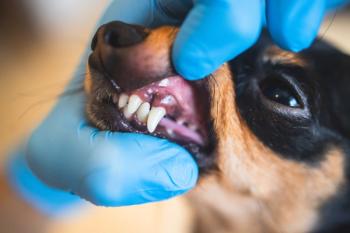
Why dental abnormalities don't always need an immediate fix
Find out when just keeping your eye on the target, and not necessarily intervening, is the best approach to dental care in your veterinary patients.
Perhaps one of the hardest things for veterinarians is to do nothing when confronted with something that is not “normal.” This is contrary to how we are taught to respond to dental disease-extract the tooth or teeth that are hopelessly damaged or repair the repairable and restore to function.
This final article in a series on how to handle dental pathology focuses on determining what conditions need to be followed and rechecked versus treated, which can be bewildering. Considering whether the dental abnormality is functional versus nonfunctional, painful versus nonpainful, and progressive versus nonprogressive helps when deciding what to do.
Normal versus abnormal occlusion
Occlusion is the term for the contact between the incising or masticating surfaces of the maxillary and mandibular teeth. Normal occlusion in a dog and cat occurs when the mandibular teeth reside just lingual to the maxillary teeth and the mandibular incisor cusps rest on the cingulum on the palatal side of the maxillary incisors (Figures 1A and 1B).
Figure 1A. Normal rostral dentition in a cat. (Photos courtesy of Dr. Jan Bellows)
Figure 1B. Normal rostral dentition in a dog.
Additionally the mandibular canine crowns should lie equally between the maxillary third incisor and maxillary canine. The mandibular premolar crown tips should point to the interproximal spaces between the crowns of the maxillary premolars. Each mandibular premolar should be positioned rostral to the corresponding maxillary premolar (Figure 1C). Dogs and cats with normal occlusion generally do not have bite-related problems.
Figure 1C. Normal cheek teeth in a dog. The premolars lie in a saw-toothed orientation.
Abnormal occlusion is any presentation other than that described above. This concept creates controversy with some breeds in which mandibular mesioclusion (underbite) is considered normal for a breed but is often not a healthy bite. Mandibular distoclusion (overbite) is never considered normal. Dogs and cats with abnormal occlusions (even if normal for their breed) need to be closely watched for tooth-to-tooth and tooth-to-gingiva dental trauma (Figures 2A and 2B).
Figures 2A and 2B. Tooth-to-tooth trauma caused by mandibular mesioclusion (underbite) in a boxer.
Interceptive orthodontics is performed to extract those primary teeth creating a dental interlock, allowing the jaws to grow to their genetic potential uninhibited. These patients need careful follow-up. Once the adult teeth fully erupt, more treatment is often needed (Figures 3A-3C).
Figures 3A and 3B. A 3-month-old schnauzer puppy affected by mandibular mesioclusion in which the maxillary primary incisors were extracted (interceptive orthodontics) to give the maxilla the ability to reach its genetic potential uninhibited.
Figure 3C. The same dog four months later. All the secondary maxillary incisors and retained deciduous canines were extracted.
Functional versus nonfunctional, painful versus pain-free
Normally functioning dental hard tissues and gingiva allow the teeth to work with efficacy and without pain. Occasionally we find teeth that are in abnormal but functional locations (Figures 4A-4C), lesions (found on intraoral radiographs) that are not normal but do not seem to adversely affect the patient (Figure 5), and teeth that have been embedded since birth discovered once the dog or cat is mature (Figure 6). Depending on the abnormality, these patients can be followed annually during the oral assessment, treatment and prevention visit to make sure that the abnormalities' effects have not changed.
Figure 4A. A functional right mandibular canine located abnormally caudal to the maxillary canine.
Figures 4B and 4C. The same patient showing that the mandibular incisors are functional and impinging but not penetrating the hard palate, thus causing no pain.
Figure 5. An apparent functional osteodense lesion between the roots of a mandibular first molar (arrows).
Figure 6. Embedded canine teeth in an 11-month-old dachshund.
Progressive versus nonprogressive
The terms stages, grades, types, classes and indices are used to catalog dental pathology.
- Stages involve the extent of pathologic lesions in the course of a disease that are likely to be progressive, such as stages of periodontal disease, tooth resorption and furcation involvement.
- Grades involve the quantitative assessment of the degree of severity of a disease or abnormal condition at the time of diagnosis, irrespective of whether the disease is progressive, such as a grade 2 mast cell tumor (based on mitotic figures).
- Types involve systematic classification according to specific characteristics in diseases, injuries and abnormalities that are not expected to progress, such as types 1, 2 and 3 tooth resorptions based on radiograph interpretation.
- Classes is a synonym for types.
- Indices are numerical expressions of predefined diagnostic criteria whereby the presence and/or severity of a pathological condition is expressed by assessing a numerical value. Examples include the gingivitis index and plaque index.
Periodontal disease and tooth resorption are two common dental diseases that are considered progressive. In cases of periodontal disease, the decision to treat or follow a patient largely depends on the stage and the client's ability as well as the patient's willingness to accept daily home plaque prevention after veterinary treatment is provided.
Tooth resorption is now a common finding in our patients thanks to detection on intraoral radiographs performed during professional oral assessment, treatment and prevention visits. When the resorption extends to the oral cavity, the treatment decision is easy-extract. When they appear radiographically to be confined subgingingivally, tooth resorptions are not considered to be painful and can be followed or proactively extracted (Figures 7A-7D).
Figure 7A. A clinically functional upper fourth premolar in an 8-year-old dog.
Figure 7B. A radiograph reveals stage 2 tooth resorption (resorption affecting the dentin only, not pulp).
Figure 7C. The clinical appearance 10 months later. The lesion progressed into the oral cavity, necessitating extraction.
Figure 7D. A radiograph confirming progression of tooth resorption.
Conclusion
The foundation of companion animal dental care is the tooth-by-tooth examination. Once dental abnormalities are discovered, think about the four Rs-remove, repair, refer or recheck. Your patients and their owners will thank you.
Dr. Jan Bellows owns All Pets Dental in Weston, Florida. He is a diplomate of the American Veterinary Dental College and the American Board of Veterinary Practitioners. He can be reached at (954) 349-5800; email: dentalvet@aol.com.
Newsletter
From exam room tips to practice management insights, get trusted veterinary news delivered straight to your inbox—subscribe to dvm360.






